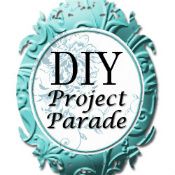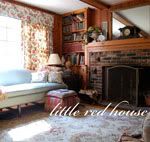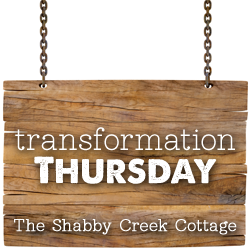BE SURE TO CHECK OUT ALL THREE NEW LINKY PARTIES HERE AT THE COTTAGE!
It's Monday night–a time to get those tough, challenging, oft-frustrating DIY questions answered by an expert.
If you've ever gotten stumped by a project and wished you had a go-to-guy for answers, this event is for you!
Leah @ Behind the Stone Wall sent out an SOS to the Yankee for some advice on how to breathe new life into this terrific old buffet she scored for free from Craigslist.
It has great classic lines, but as she aptly put it, "...it needs a good bit of TLC."
There is a section of veneer missing from one of the drawers and...
it has some rather nasty scratches, scuffs, and discoloration.
So what did the Yankee advise?
Though Leah is thinking of borrowing a piece of veneer from inside one of the doors, or from one of the feet, I would suggest leaving everything intact and purchasing new veneer for this project.
It is such a beautiful piece, and stripping what is needed from another area would only create an eyesore on that part of the buffet.
Of course, it's always possible to stumble upon a sacrificial piece–a small stool or table–with veneer that could be used for such a project.
Just make sure to match the type of wood–which appears to be mahogany–and the wood grain.
I'll let Leah decide for herself where she will get the veneer from and merely address installation.
Since I don't have access to the actual buffet, and I'm not currently working on any pieces of furniture with such issues, I had to come up with a visual mock-up to explain the procedure.
The white board represents the damaged buffet drawer. The area colored in with black marker represents the damaged area. The yellow strip of paper above it, represents a strip of veneer that has been cut for the project.
The first step would be to clamp the replacement piece to the damaged area.
Normally, replacement veneer is cut in an irregular shape to help disguise the patch. For this project, I felt it would be easiest for Leah to just use straight lines.
It's best to replace as little of the original veneer as possible, in order to maintain the integrity of the piece.
With a sharp utility knife, score along the inside edge of the new veneer. If you look back at the picture above, the red-dotted line represents the area that would be scored with the knife.
Note also that there is a small amount of veneer hanging over the edges of the board. That will be addressed later in our discussion.
Once you have scored the piece, use the utility knife, or a sharp flat knife, to remove all the old veneer above the score line.
Next, use a sanding pad or sandpaper to sand away any glue and rough spots. You want a smooth flat surface for the new patch to adhere to.
Veneer is so thin any imperfections below will show through.
Once that step has been completed and the area has been cleaned, use painter's tape and tape a piece of newspaper below the area to be repaired.
Carefully follow the instructions on the can of adhesive, spray a light coat on the area where the repair will be made–represented by the black area on the demonstration board–and on the back side of the veneer strip.
Wait the alloted time before attempting to place the patch on. You must be extremely careful when putting the new piece on, because once the two sides make contact you cannot move the patch.
I suggest visually lining it up and only permitting a small amount of the veneer at a time to make contact. You can smooth it out with your fingers as you go along.
Now you can place the piece face down and use the utility knife to cut away the excess.
I often use denatured alcohol–applied with 000 steel wool, going with the grain of the wood–to refinish pieces like Leah's buffet. It would take care of the scratches, scuffs, marks.
However, it would then require restaining the piece. But, it would also provide the best way to match the new patched area.
With some elbow grease, Leah's buffet could truly be a diamond in the rough.
Do you have a question for the Yankee?
Here's the scoop for linking up:
Create a post on your blog addressing your DIY question and showing others where you're stuck in your project and need direction.
Link your post to the Ask the Yankee event with a direct link–not one to your main blog–and
link back to the Brambleberry Cottage.
Or...
Leave your question in the comment section of this Ask the Yankee post, and place the event button on your blog's sidebar.
Next week, a DIY question or two–along with their solutions–will be featured at the cottage.

















































































































I only have 3 words
ReplyDeleteI WANT IT!!!!!
its just stunning!!!!!